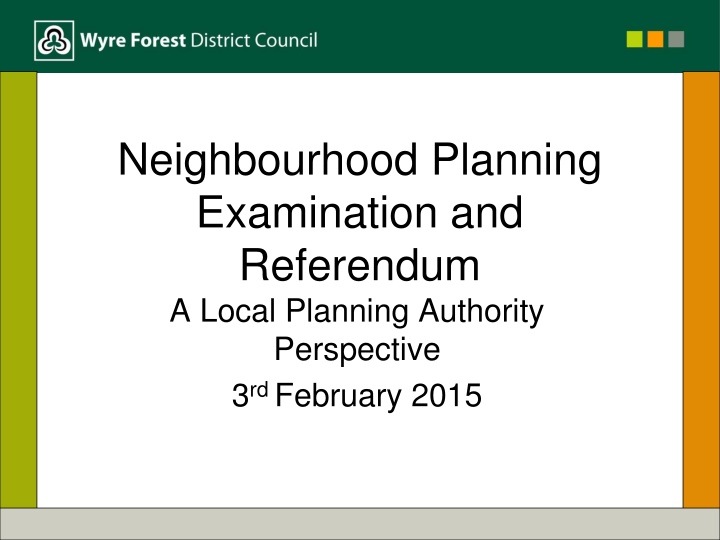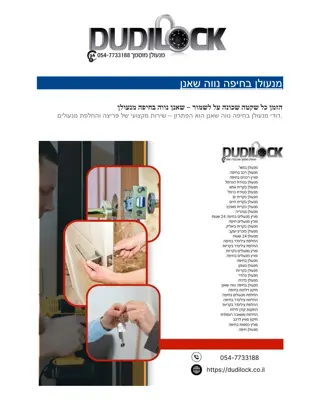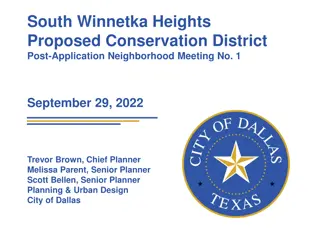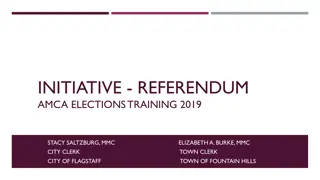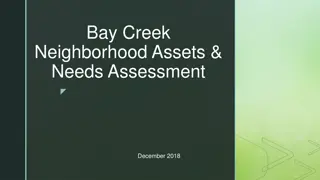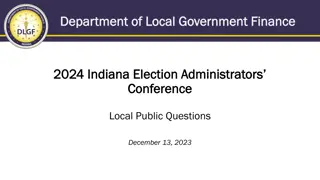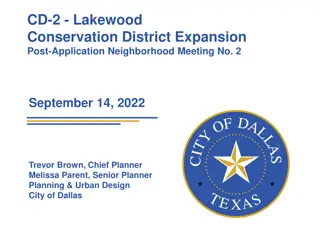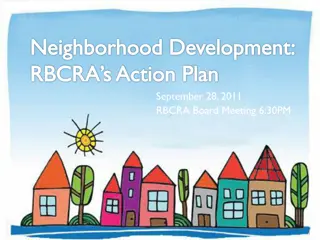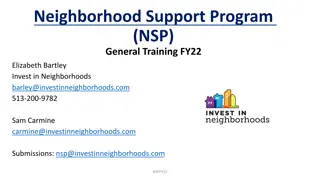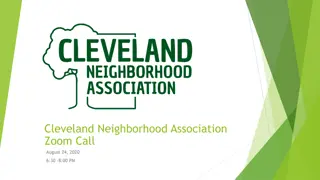Neighborhood Planning Examination and Referendum Overview
In this article, we delve into the process of neighborhood planning examinations and referendums from a local planning authority perspective. The discussion covers the purpose, appointment of examiners, referendum arrangements, and the electorate's role. It also provides insights into the current status nationally and locally, along with specific case studies like the Wyre Forest District Council's neighborhood plans. Key stages such as plan submissions, examinations, and meeting basic conditions are outlined, shedding light on the intricacies of the process.
Download Presentation

Please find below an Image/Link to download the presentation.
The content on the website is provided AS IS for your information and personal use only. It may not be sold, licensed, or shared on other websites without obtaining consent from the author.If you encounter any issues during the download, it is possible that the publisher has removed the file from their server.
You are allowed to download the files provided on this website for personal or commercial use, subject to the condition that they are used lawfully. All files are the property of their respective owners.
The content on the website is provided AS IS for your information and personal use only. It may not be sold, licensed, or shared on other websites without obtaining consent from the author.
E N D
Presentation Transcript
Neighbourhood Planning Examination and Referendum A Local Planning Authority Perspective 3rd February 2015
Introduction Where we are now Examination: Purpose Process Appointing an Examiner Examiner s Report Referendum Arrangements Electorate
Where Are We Now? - Nationally Over 1,300 communities have begun the Neighbourhood Planning process 44 successful referendums with five planned in January and February. Many more plans are at or nearing examination
Where Are We Now - Locally Plans at Publication Stage? Plans at Examination Stage? Plans at Referendum Stage?
Wyre Forest District Council Chaddesley Corbett Neighbourhood Plan Made September 2014 Churchill and Blakedown Neighbourhood Plan Regulation 14 consultation expected Sumer 2015 Early discussions with Bewdley Town Council
Wyre Forest District Council Policy Context Adopted Core Strategy (December 2011) Publication Site Allocations and Policies and Kidderminster Central Area Action Plan DPDs (July 2012)
Submission LPA must satisfy itself that the submitted Plan complies with all statutory requirements before presenting it for examination. LPA does not make a judgement as to whether the Plan meets the Basic Conditions until after the Examiner s Report has been received. Publicise Plan for six weeks
The Examination The examinations tests the Plan against the Basic Conditions. No test of soundness No other material considerations are examined.
The Examination Process Written representations Can be a public hearing but this is unlikely The Basic Conditions Statement is important in demonstrating how the Basic Conditions have been met. Representations submitted during the Publication period will be considered during the Examination.
The Examiner The examiner can be anyone who meets the criteria in The Localism Act 2011: (a)is independent of the qualifying body and the authority, (b) does not have an interest in any land that may be affected by the draft order, and (c) has appropriate qualifications and experience. Suitable candidates will often be planning consultants or other planning professionals, employees of another LPA or planning inspectors.
NPIERS Referral Service Application form 3 CVs provided tailored to plan and examiner availability Qualifying Body and LPA must agree appointment Contract is between LPA and Examiner, NPIERS set daily rate
Appointing The Examiner - Issues Timescales Agreement between LPA and Qualifying Body Sole practitioners PII may be lower than what is usually required by LPA weigh up the risk. Expenses are additional to daily rate
The Examiners Report The examiner will determine whether or not the plan meets the Basic Conditions The report may set out recommendations which are required to be addressed and other recommendations. Will make recommendations on the referendum area
Chaddesley Corbett Examiner s Report Set out required changes as well as advisory changes Recommendations were discussed with the Parish Council Recommended that the Neighbourhood Plan area was the boundary for the Referendum area
Decision Statement LPA are required to publish a Decision Statement following receipt of Examiner s Report. Statement should set out whether or not the Plan will proceed to referendum. If the Plan is to proceed to referendum, the date of the referendum should be included.
The Referendum Organised and funded by the relevant Council New Burdens funding Must be conducted in accordance with: Neighbourhood Planning referendum Regulations 2012, as amended by the Neighbourhood Planning (Referendum) (Amendment) Regulations 2013 Neighbourhood Planning (Prescribed Dates) Regulations 2012 Combined Polls
Who Votes? Any person within the Referendum area who meets the criteria to vote in a local election. In designated business areas businesses get to vote: Two polls If results differ LPA decides Much longer lead in time
The Poll No minimum turn-out Considerable variation in turn-outs to date Simple majority Yes vote Plan made No vote Plan can not be made
Chaddesley Corbett Turn out 27.8% 81% in favour, 19% against No active campaign for or against the Plan
Poll Results and Decision Statement Poll results were published in accordance with the Regulations. A decision statement was approved at September Council and the Plan was formally made
Costs Examination estimated 3K Referendum expenditure estimated 3.5K excluding officer time
Conclusions and Top Tips Maintain a continuous working relationship with the Qualifying Body where possible Think about the examination as early as you can Work with the elections team at the earliest opportunity. Ensure that the Qualifying Body understand and promote the importance of the referendum throughout the Neighbourhood Planning process.
